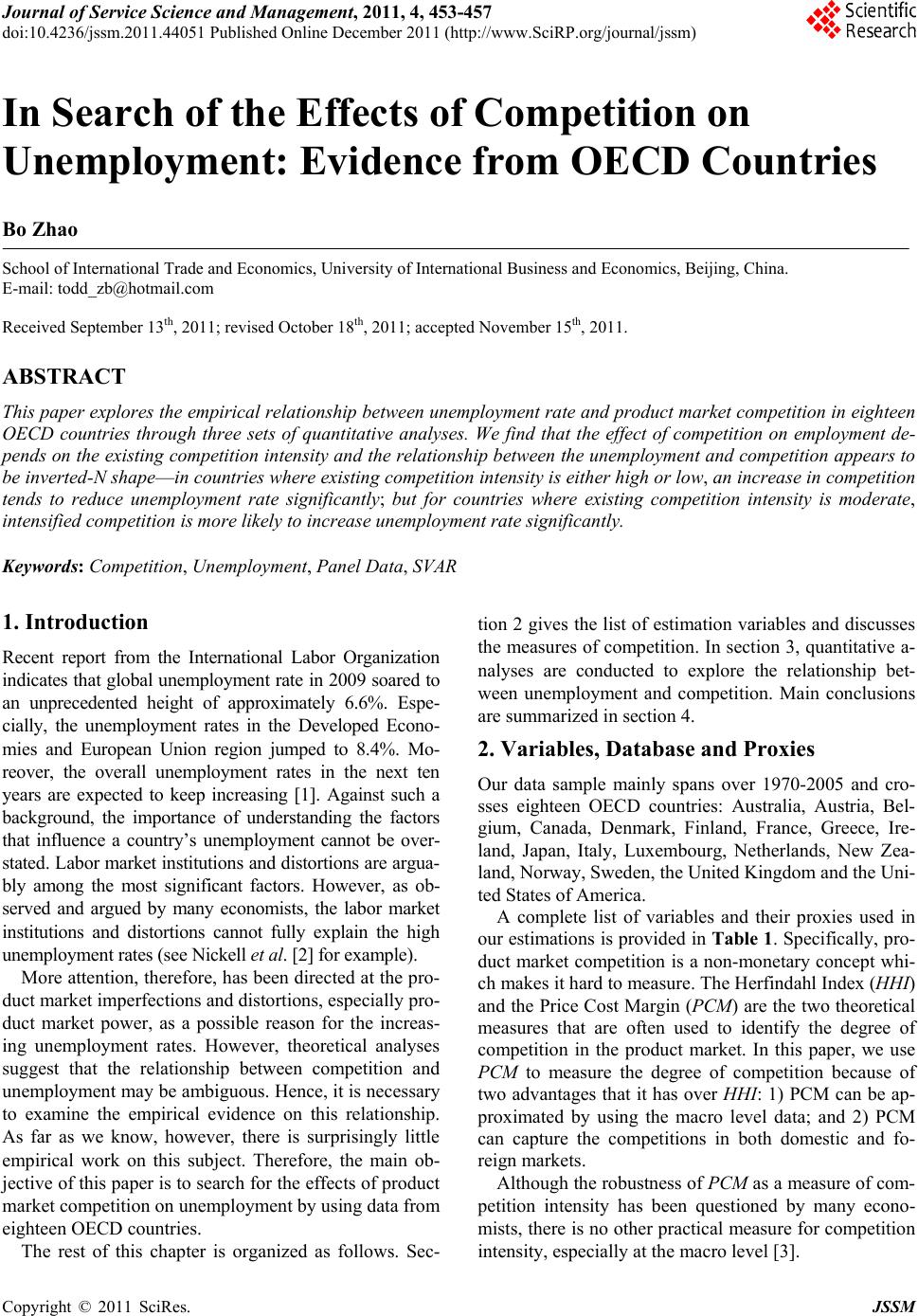
Journal of Service Science and Management, 2011, 4, 453-457
doi:10.4236/jssm.2011.44051 Published Online December 2011 (http://www.SciRP.org/journal/jssm)
Copyright © 2011 SciRes. JSSM
453
In Search of the Effects of Competition on
Unemployment: Evidence from OECD Countries
Bo Zhao
School of International Trade and Economics, University of International Business and Economics, Beijing, China.
E-mail: todd_zb@hotmail.com
Received September 13th, 2011; revised October 18th, 2011; accepted November 15th, 2011.
ABSTRACT
This paper explores the empirical relationship between unemployment rate and product market competition in eighteen
OECD countries through three sets of quantitative analyses. We find that the effect of competition on employment de-
pends on the existing competition intensity and the relationship between the unemployment and competition appears to
be inverted-N shape—in countries where existing competition intensity is either high or low, an increase in competition
tends to reduce unemployment rate significantly; but for countries where existing competition intensity is moderate,
intensified competition is more likely to increase unemployment rate significantly.
Keywords: Competition, Unemployment, Panel Data, SVAR
1. Introduction
Recent report from the International Labor Organization
indicates that global unemployment rate in 2009 soared to
an unprecedented height of approximately 6.6%. Espe-
cially, the unemployment rates in the Developed Econo-
mies and European Union region jumped to 8.4%. Mo-
reover, the overall unemployment rates in the next ten
years are expected to keep increasing [1]. Against such a
background, the importance of understanding the factors
that influence a country’s unemployment cannot be over-
stated. Labor market institutions and distortions are argua-
bly among the most significant factors. However, as ob-
served and argued by many economists, the labor market
institutions and distortions cannot fully explain the high
unemployment rates (see Nickell et al. [2] for example).
More attention, therefore, has been directed at the pro-
duct market imperfections and distortions, especially pro-
duct market power, as a possible reason for the increas-
ing unemployment rates. However, theoretical analyses
suggest that the relationship between competition and
unemployment may be ambiguous. Hence, it is necessary
to examine the empirical evidence on this relationship.
As far as we know, however, there is surprisingly little
empirical work on this subject. Therefore, the main ob-
jective of this paper is to search for the effects of product
market competition on unemployment by using data from
eighteen OECD countries.
The rest of this chapter is organized as follows. Sec-
tion 2 gives the list of estimation variables and discusses
the measures of competition. In section 3, quantitative a-
nalyses are conducted to explore the relationship bet-
ween unemployment and competition. Main conclusions
are summarized in section 4.
2. Variables, Database and Proxies
Our data sample mainly spans over 1970-2005 and cro-
sses eighteen OECD countries: Australia, Austria, Bel-
gium, Canada, Denmark, Finland, France, Greece, Ire-
land, Japan, Italy, Luxembourg, Netherlands, New Zea-
land, Norway, Sweden, the United Kingdom and the Uni-
ted States of America.
A complete list of variables and their proxies used in
our estimations is provided in Table 1. Specifically, pro-
duct market competition is a non-monetary concept whi-
ch makes it hard to measure. The Herfindahl Index (HHI)
and the Price Cost Margin (PCM) are the two theoretical
measures that are often used to identify the degree of
competition in the product market. In this paper, we use
PCM to measure the degree of competition because of
two advantages that it has over HHI: 1) PCM can be ap-
proximated by using the macro level data; and 2) PCM
can capture the competitions in both domestic and fo-
reign markets.
Although the robustness of PCM as a measure of com-
petition intensity has been questioned by many econo-
mists, there is no other practical measure for competition
intensity, especially at the macro level [3].